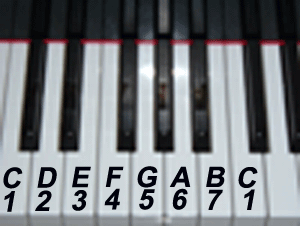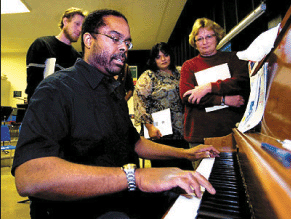by Charley Wyser
There are four chords that are the basic foundation for almost all chords in music as played in the United States and other parts of the world.
Each of these chords consists of three notes. These four chords are the Major, minor, Augmented, and diminished chords.
In this article, you will learn about these chords in the key of C.
You will notice when the four chords were mentioned above, Major and Augmented begin with upper-case letters, and minor and diminished begin with lower-case letters. This is because chords that are Major, or formed from the Major chord start with an upper-case letter, and chords that are minor, or formed from the minor chord are in lower-case.
You will see how this works in just a few minutes.
To begin, let's start by forming a C Major scale.
Think about your younger school days when you learned Do - Re - Mi - Fa - So - La - Ti - Do.
When you sang this, you were singing a Major scale.
The notes that make up the C Major scale are in the picture below.
 What I have done is numbered the tones in the C Major scale from 1 to 7. Many times, you will hear teachers refer to a Major scale as having eight tones. But, if you look closely at the eighth tone, you will notice that it is the same as the first tone.
What I have done is numbered the tones in the C Major scale from 1 to 7. Many times, you will hear teachers refer to a Major scale as having eight tones. But, if you look closely at the eighth tone, you will notice that it is the same as the first tone.
Therefore, we will re-label it as tone number one.
These tones are going to be important in the formation of our four basic chords.
(the symbol 'b' is a flat. Eb is the same as E flat.)
1) Major chord: 1 - 3 - 5 -> C Major chord = C, E, G
2) minor chord: 1 - b3 - 5 - > C minor chord = C, Eb, G
3) Augmented chord: 1 - 3 - #5 -> C Augmented chord = C, E, G#
4) diminished chord: 1 - b3 - b5 -> C diminished chord = C, Eb, Gb
If you look at the above chart, you will start to see relationships between the four chords. Pay close attention to the 3rd.
In the Major, and Augmented chords, you will see that they both start with the 1 (referred to as the root of the chord), and the 3. This is why they are related. The only thing that changes is the treatment of the 5.
You will notice a similar relationship with the minor and diminished chords. The 3 is now flatted (b3). That is, both the minor and diminished chord begin with the root and the flat 3. Again, this is why they are related.
We covered these four basic chords in the key of C. Remember, in music, you should become familiar with these chords in all twelve keys. Becoming familiar with these chords will carry you a long way in your musical endeavors.
In my program, 4 Chords You Need To Know, you will learn these chords in all twelve keys. You will also learn how to apply them to songs, and learn shortcuts for figuring out any of these chords in matter of seconds in any key (even if you have never played them in that key before).
Until next time, continue to have fun on your piano journey!
Charley Wyser
www.easypiano.com
To view my free online lessons, click here
To listen to podcasts, click here
Each of these chords consists of three notes. These four chords are the Major, minor, Augmented, and diminished chords.
In this article, you will learn about these chords in the key of C.
You will notice when the four chords were mentioned above, Major and Augmented begin with upper-case letters, and minor and diminished begin with lower-case letters. This is because chords that are Major, or formed from the Major chord start with an upper-case letter, and chords that are minor, or formed from the minor chord are in lower-case.
You will see how this works in just a few minutes.
To begin, let's start by forming a C Major scale.
Think about your younger school days when you learned Do - Re - Mi - Fa - So - La - Ti - Do.
When you sang this, you were singing a Major scale.
The notes that make up the C Major scale are in the picture below.
 What I have done is numbered the tones in the C Major scale from 1 to 7. Many times, you will hear teachers refer to a Major scale as having eight tones. But, if you look closely at the eighth tone, you will notice that it is the same as the first tone.
What I have done is numbered the tones in the C Major scale from 1 to 7. Many times, you will hear teachers refer to a Major scale as having eight tones. But, if you look closely at the eighth tone, you will notice that it is the same as the first tone.Therefore, we will re-label it as tone number one.
These tones are going to be important in the formation of our four basic chords.
(the symbol 'b' is a flat. Eb is the same as E flat.)
1) Major chord: 1 - 3 - 5 -> C Major chord = C, E, G
2) minor chord: 1 - b3 - 5 - > C minor chord = C, Eb, G
3) Augmented chord: 1 - 3 - #5 -> C Augmented chord = C, E, G#
4) diminished chord: 1 - b3 - b5 -> C diminished chord = C, Eb, Gb
If you look at the above chart, you will start to see relationships between the four chords. Pay close attention to the 3rd.
In the Major, and Augmented chords, you will see that they both start with the 1 (referred to as the root of the chord), and the 3. This is why they are related. The only thing that changes is the treatment of the 5.
You will notice a similar relationship with the minor and diminished chords. The 3 is now flatted (b3). That is, both the minor and diminished chord begin with the root and the flat 3. Again, this is why they are related.
We covered these four basic chords in the key of C. Remember, in music, you should become familiar with these chords in all twelve keys. Becoming familiar with these chords will carry you a long way in your musical endeavors.
In my program, 4 Chords You Need To Know, you will learn these chords in all twelve keys. You will also learn how to apply them to songs, and learn shortcuts for figuring out any of these chords in matter of seconds in any key (even if you have never played them in that key before).
Until next time, continue to have fun on your piano journey!
Charley Wyser
www.easypiano.com
To view my free online lessons, click here
To listen to podcasts, click here






No comments:
Post a Comment